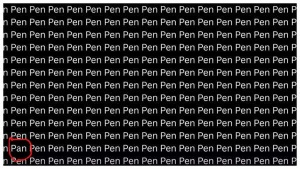Optical illusions are not just a source of entertainment; they also provide a fascinating glimpse into how our brains work. These visual puzzles challenge our perception and can reveal surprising aspects of our personality. A recent optical illusion shared by Marina Winberg has taken social media by storm, prompting users to delve deeper into their own minds.

At first glance, the image presents two possibilities: an eaten apple core or two faces gazing at each other. According to Winberg, whichever image you notice first can reveal significant insights into your mindset. Take a moment to carefully examine the image before reading on to discover what your initial perception says about you.
Winberg explained that this image is a "classic dual-illusion" where individuals perceive either two faces (a man and a woman) or an apple core. Your initial observation is believed to be indicative of your underlying thought processes and character traits.
If you immediately recognized the two faces, it suggests that you are a logical and analytical thinker with a strong moral compass. You are likely to carefully consider your actions before making a move, valuing stability and employing creative problem-solving techniques. However, your curiosity can sometimes lead you down unexpected paths.
Alternatively, if the apple core was the first thing you saw, it indicates that you are an intuitive and emotionally intelligent individual. You possess a remarkable ability to read subtle cues and understand unspoken emotions. While you often know the right words to say, you may choose to remain silent. Stability is important to you, and you are fiercely protective of the things you hold dear.
Optical illusions occur because our brains attempt to interpret visual information, sometimes leading to misinterpretations. There are three primary categories of optical illusions:
By understanding how these illusions work, we can gain a greater appreciation for the complexities of human perception and the remarkable capabilities of the human brain.
Newer articles
Older articles
 SA20 Teams Given Six Retention Options Ahead of Season 4 Auction
SA20 Teams Given Six Retention Options Ahead of Season 4 Auction
 Gavaskar Calls for Kuldeep Yadav's Inclusion in Second Test Amid Bumrah Fitness Concerns
Gavaskar Calls for Kuldeep Yadav's Inclusion in Second Test Amid Bumrah Fitness Concerns
 Former Selector Blasts India's Fielding Errors After Test Defeat to England
Former Selector Blasts India's Fielding Errors After Test Defeat to England
 Rishabh Pant is 'Reinventing' Cricket, Says Greg Chappell, Following Heroic Test Display
Rishabh Pant is 'Reinventing' Cricket, Says Greg Chappell, Following Heroic Test Display
 5 Daily Practices That Radiate Confidence
5 Daily Practices That Radiate Confidence
 Test Your Focus: Spot the Hidden Word in This Optical Illusion Challenge
Test Your Focus: Spot the Hidden Word in This Optical Illusion Challenge
 Messi, 38, Recreates "Ankara Messi" Magic with Stunning Solo Goal for Inter Miami
Messi, 38, Recreates "Ankara Messi" Magic with Stunning Solo Goal for Inter Miami
 Expert Dismisses Claim That Eating Fruit on Empty Stomach Raises Diabetes Risk
Expert Dismisses Claim That Eating Fruit on Empty Stomach Raises Diabetes Risk
 Nine-Year-Old Indian Chess Prodigy Holds Magnus Carlsen to Draw in Online Tournament
Nine-Year-Old Indian Chess Prodigy Holds Magnus Carlsen to Draw in Online Tournament
 Mirabai Chanu Reveals Relentless Demands of Weightlifting: Training, Weight Control Consume Mind Even During Family Time
Mirabai Chanu Reveals Relentless Demands of Weightlifting: Training, Weight Control Consume Mind Even During Family Time